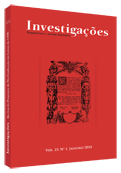Formas históricas: o romance e a cisão do mundo
Abstract
Utilizando-se da noção de “formas históricas”, o presente trabalho busca compreender, na passagem da epopeia ao romance, como condições históricas e filosóficas foram plasmadas por este gênero, permitindo-o tornar-se a forma literária por excelência da era moderna. Analisaremos a sua representação de uma paisagem humana cujo significado lhe é imanente (e não transcendental, como na epopeia), seu modo particular de apreensão dos mitos e o seu caráter intensamente subjetivo, arguindo suas possibilidades de urdir o eu e o outro ao mesmo tempo em que é considerado uma “forma da crise”References
ARISTÓTELES. 2005. Poética. In. ARISTÓTELES; HORÁCIO; LONGINO. A poética clássica. 12. ed. São Paulo: Cultrix, pp. 19-52.
BAKHTIN, Mikhail. 1998. Epos e romance (sobre a metodologia do estudo do romance). In: _____. Questões de Literatura e de Estética (A Teoria do Romance). 4. ed. São Paulo: Editora UNESP, pp. 397-427.
CANCLINI, Néstor García. 2003. Quién habla y en qué lugar: sujetos simulados e interculturalidad. Estudos de literatura brasileira contemporânea. Brasília, n. 22, pp. 15-37, julho/dezembro.
FRYE, Northrop. 2000. Fábulas de identidade: ensaios sobre mitopoética. São Paulo: Nova Alexandria.
HALL, Stuart. 2006. A identidade em questão. In: _____. A identidade cultural na pós-modernidade. Rio de Janeiro: DP&A, pp. 7-22.
JAMESON, Frederic. 1985. Em defesa de Georg Lukács. In: –. Marxismo e forma: teorias dialéticas da literatura no século XX. São Paulo: Editora HUCITEC, pp. 127-160.
JOLLES, André. 1976. O Mito. In: _____. Formas simples. São Paulo: Cultrix, PP. 83-108.
KANT, Immanuel. 2003. Crítica da razão pura. São Paulo: Martin Claret.
LIMA, Luiz Costa. 2003. A explosão das sombras: mímesis entre os gregos. In: _____. Mímesis e modernidade: formas das sombras. 2. ed. São Paulo: Paz e Terra, pp. 25-84.
LUKÁCS, Georg. 2000. A teoria do romance: um ensaio histórico-filosófico sobre as formas da grande épica. 34. ed. São Paulo: Duas Cidades.
RODRIGUES, Raquel Imanish. 2005. Teatro e crise. Novos estudos CEBRAP. São Paulo, n. 71, pp. 209-219, mar.
SZONDI, Peter. 2001. Teoria do drama moderno [1880-1950]. São Paulo: Cosac & Naify Edições.
WATT, Ian. 1990. O realismo e a forma romance. In: _____. A ascensão do romance: estudos sobre Defoe, Richardson e Fielding. São Paulo: Companhia das Letras, pp. 11-33.
Downloads
Published
How to Cite
Issue
Section
License
Copyright (c) 2010 Newton de Castro Pontes

This work is licensed under a Creative Commons Attribution 4.0 International License.
Authors who publish with Revista Investigações agree to the following terms:
Authors retain copyright and grant the journal right of first publication with the work simultaneously licensed under the Creative Commons Attribution 4.0 International (CC BY 4.0) license that allows others to share the work with an acknowledgement of the work's authorship and initial publication in this journal.
Authors are able to enter into separate, additional contractual arrangements for the non-exclusive distribution of the journal's published version of the work (e.g., post it to an institutional repository or publish it in a book), with an acknowledgement of its initial publication in this journal.
You are free to:
Share — copy and redistribute the material in any medium or format for any purpose, even commercially.
Adapt — remix, transform, and build upon the material for any purpose, even commercially.
The licensor cannot revoke these freedoms as long as you follow the license terms.
Under the following terms:
Attribution — You must give appropriate credit , provide a link to the license, and indicate if changes were made . You may do so in any reasonable manner, but not in any way that suggests the licensor endorses you or your use.
No additional restrictions — You may not apply legal terms or technological measures that legally restrict others from doing anything the license permits.

